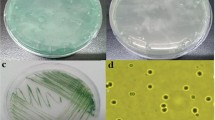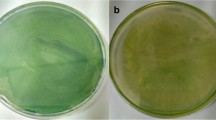Abstract
The algicidal activity of the terrestrial plants is a novel and promising means for alga control of eutrophic waters. In this study, three compositae plants — Artemisia annua (A. annua), Conyza canadensis (C. canadensis), and Erigeron annuus (E. annuus) were selected and antialgal activity of petroleum ether (PE), ethyl acetate (EA) and ethanol extracts of these plants on blue algae Microcystis aeruginosa was investigated. The result shows the EA extracts of these plants present the stronger inhibitory effects. The results of the further separation of PE and EA extracts according to water-solubility and acidity or alkalinity show that fatty acids and terpenoids in A. annua, terpenoids and organic acid in C. Canadensis and E. Annuus may be the main antialgal active constituents. This study suggested that the EA extracts of these plants could become the potential algicide to prevent water blooming.
Similar content being viewed by others
References
Jeong JH, Jin HJ, Sohn CH, Suh KH, Hong YK. Algicidal activity of the seaweed Corallina pilulifera against red tide microalgae. J Appli Phycology, 2000, 12(1): 37–43
Sun XX, Choi JK, Kim EK. A preliminary study on the mechanism of harmful algal bloom mitigation by use of sophorolipid treatment. J Exp Mar Biol Ecol, 2004, 304(1): 35–49
Hasler AD, Jones E. Demonstration of the antagonistic action of large aquatic plants on algae and rotifers. Ecology, 1949, 30(3): 359–364
Macías F, Galindo J, Garcia-Díaz M, Gahlindo J. Allelopathic agents from aquatic ecosystems: Potential biopesticides models. Phytochem Rev, 2008, 7(1): 155–178
Andrew SB MW, David V, James R. Algal growth control by a barley straw extract. Bioresour Technol, 2001, 77: 177–181
Tsuda K, Takamura N, Matsuyama M, Fujii Y. Assessment method for leaf litters allelopathic effect on cyanobacteria. J Aquat Plant Manage, 2005, 43: 43–46
Gross EM. Allelopathy of aquatic autotrophs. Crit Rev Plant Sci, 2003, 22(3–4): 313–339
Zhou LH, Zheng TL, Chen XH, Wang X, Chen SB, Tian Y, Hong HS. The inhibitory effects of garlic (Allium sativum) and diallyl trisulfide on alexandrium tamarense and other harmful algal species. J Appl Phycol, 2008, 20(4): 349–358
Zhou LH, Zheng TL, Wang X, Ye JL, Tian Y, Hong HS. Effect of five Chinese traditional medicines on the biological activity of a red-tide causing alga-Alexandrium tamarense. Harmful Algae, 2007, 6(3): 354–360
Kong CH, Wang P, Zhang CX, Zhang MX, Hu F. Herbicidal potential of allelochemicals from Lantana camara against Eichhornia crassipes and the alga Microcystis aeruginosa. Weed Res, 2006, 46(4): 290–295
Bruckner DJ, Lepossa AA, Herpai IZ. Ragweed allelopathay: Indirect interactions. Novenytermeles, 2001, 50(2–3): 231–236
Tellez M, Estell R, Fredrickson E, Powell J, Wedge D, Schrader K, Kobaisy M. Extracts of Flourensia cernua (L): Volatile constituents and antifungal, antialgal, and antitermite bioactivities. J Chem Ecol, 2001, 27(11): 2263–2273
Zhou K. The research progress of compositae on allelopathy. Acta Ecological Sinica, 2004, 24(8): 1780–1788 (in Chinese)
Zhan YL, Lu P, Wu XF. A Review of researches on phytoallelopathy in algal inhibition. Environ Sci Manage, 2006, 7(31): 50–52
Zhang W, Xu F, He W, Zheng X, Yang C. Inhibitive effects of three compositae plants on Microcystis aeruginosa. Front Environ Sci Engin China, 2009, 3(1): 48–55
Goel D, Goel R, Singh V, Ali M, Mallavarapu GR, Kumar S. Composition of the essential oil from the root of Artemisia annua. J Nat Med, 2007, 61(4): 458–461
Lis A, Piggott JR, Gora J. Chemical composition variability of the essential oil of Conyza canadensis Cronq. Flavour Frag J, 2003. 18(5): 364–367
Lydon J, Teasdale JR, Chen PK. Allelopathic activity of annual wormwood (Artemisia annua) and the role of artemisinin. Weed Science, 1997, 45(6): 807–811
Fang F, Mao W, Gu SL. Study on allelopathic effects of the invasive plant annua l fleabane. Bull Bot Res, 2005, 25(04): 449–452
Hayet E, Mahe M, Samia A, Ali MM, Souhir B, Abderaouf K, Mighri Z, Mahjoub A. Antibacterial, antioxidant and cytotoxic activities of extracts of Conyza canadensis (L.) Cronquist growing in Tunisia. Med Chem Res, 2009, 18(6): 447–454
Hong Y, Hu HY, Xie X, Li FM. Responses of enzymatic antioxidants and non-enzymatic antioxidants in the cyanobacterium Microcystis aeruginosa to the allelochemical ethyl 2-methyl acetoacetate (EMA) isolated from reed (Phragmites communis). J Plant Physiol, 2008, 165(12): 1264–1273
ISO (2004) Water quality — Freshwater algal growth inhibition test with unicellular green algae
Li, FM, Hu HY. Growth inhibition of water bloom algae by allelopathic effects of macrophytes. China Water Wastewater, 2004, 20(11): 18–21
Chen Y. The Constituents of Phytochemistry. BeiJing: Chemical Industry Press, 2004
Kim JY, Alamsjah MA, Hamada A, Fujita Y, Ishibashi F. Algicidal diterpenes from the brown alga Dictyota dichotoma. Biosci Biotech Biochem, 2006, 70(1): 2571–2574
Ridge I, Walters J, Street M. Algal growth control by terrestrial leaf litter: A realistic tool? Hydrobiologia, 1999, 395–396: 173–180
Author information
Authors and Affiliations
Corresponding author
Rights and permissions
About this article
Cite this article
Ni, L., Hao, X., Li, S. et al. Inhibitory effects of the extracts with different solvents from three compositae plants on cyanobacterium Microcystis aeruginosas . Sci. China Chem. 54, 1123–1129 (2011). https://doi.org/10.1007/s11426-011-4269-z
Received:
Accepted:
Published:
Issue Date:
DOI: https://doi.org/10.1007/s11426-011-4269-z




